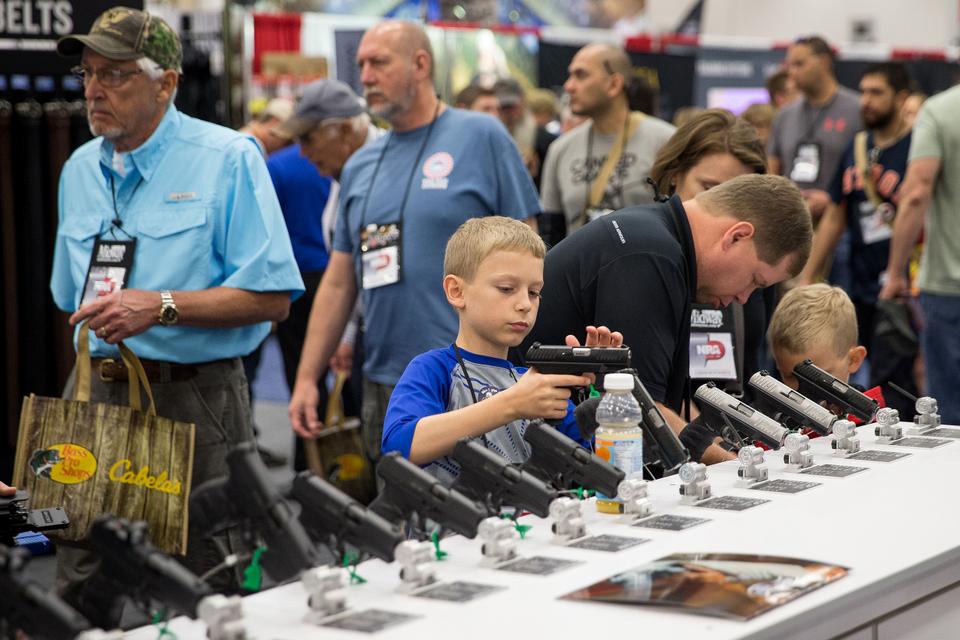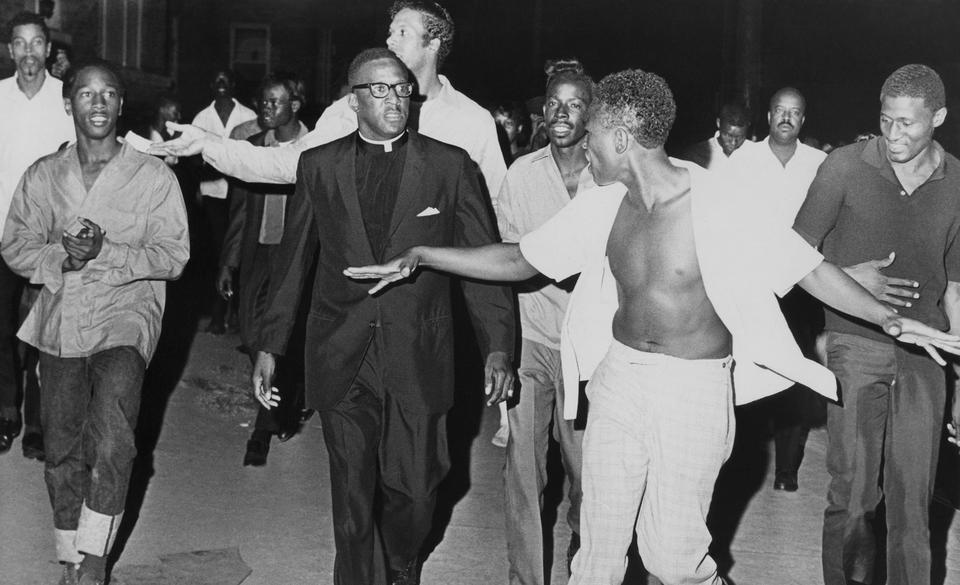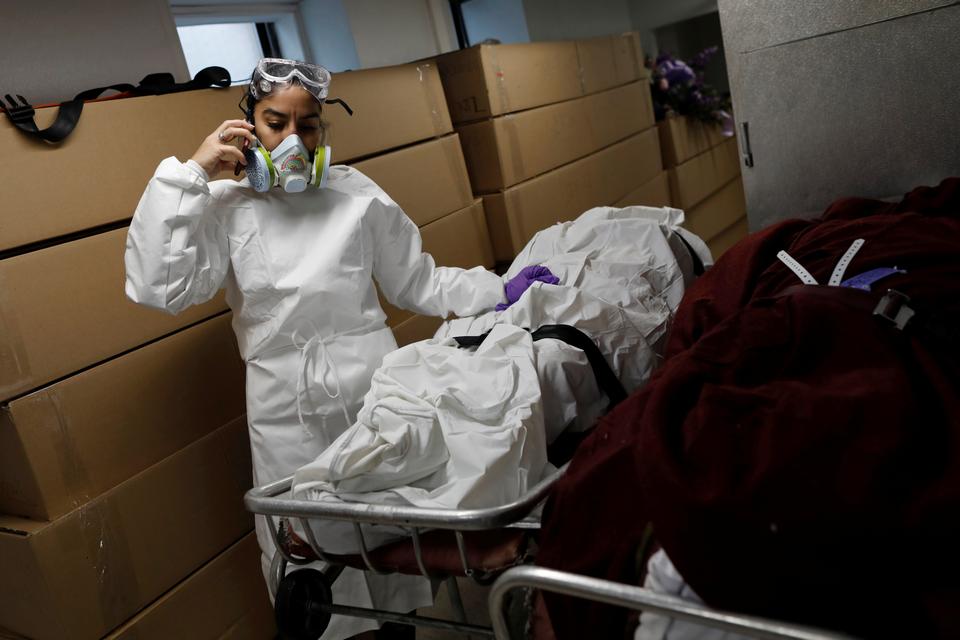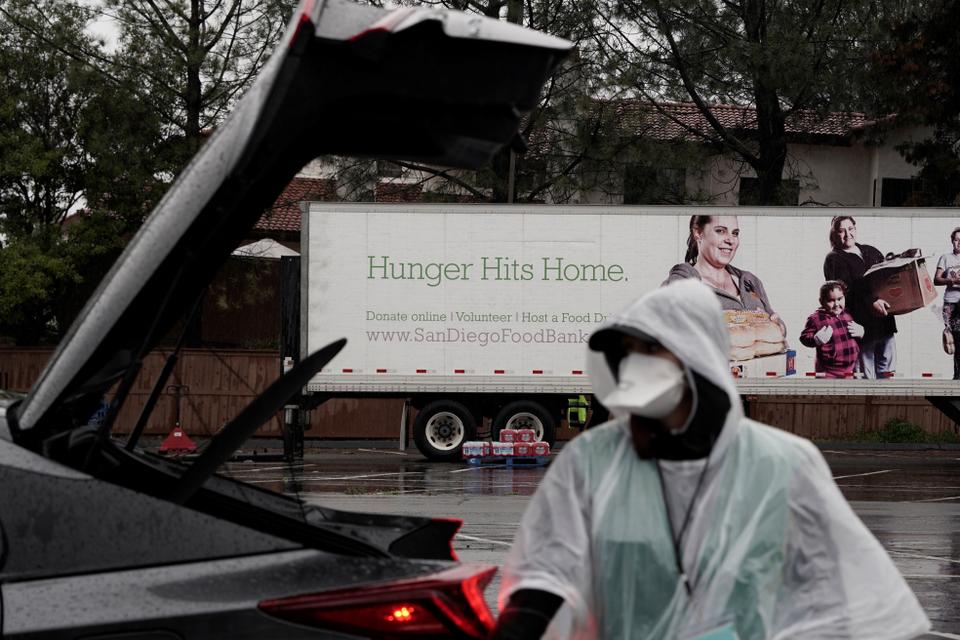The country is headed for a period when desperation, paranoia, and racism, allied with a climate of fear and uncertainty, could start a chain reaction that leads to not just economic collapse, but a violent and indefinite period of social collapse.
This week, Turkey sent half a million surgical masks, 4,000 gowns and 2,000 litres of disinfectant for healthcare workers in the US, struggling to contain the world’s worst outbreak of the coronavirus.
The donation from Turkey will save lives, but there is nothing any other country can do to help the US contain the explosive combination of the longrunning public health crisis, of gun violence and deep social divisions with the very new public health crisis of coronavirus.
The US has a number of pre-existing conditions that make it difficult to insure it against total collapse under the strain of Covid-19. As I write this, the disease has killed at least 60,000 Americans and infected at least a million more. The global toll is 217,000 known deaths with at least 3.1 million recorded infections.
Today, there are between 300 million and 400 million firearms in the US, in the hands of around 50 million Americans, including a few million who own dozens or even hundreds of them. All the same, that means there is one deadly weapon each for all of the 328 million American citizens. And guns already kill around 40,000 Americans a year. Under the pressures of pandemic and poverty, that number could rise, spurring a pandemic of violence on top of the health crisis. The rate of gun ownership is second only to Yemen.

The period of instability
US President Donald Trump has been frustrated by state-level lockdown orders that have turned a humming economy into a constellation of ghost towns. The jobless rate, set to hit 30 percent within months, is an existential threat to Trump’s presidency, if elections go forward in November. It also might be an existential threat to the US as it occupies the borders it has now. Trump has declared his authority is ‘’total’’ to lift lockdowns in states, a claim that reeked of ignorance and panic. But ignorance and panic can be contagious.
“He’s encouraging his followers to break state laws, and targeting Democratic governors and other politicians,’’ said Oregon-based journalist Jason Wilson, who has been covering the shape of radical right-wing movements in the United States. He’s referring to armed groups of Americans gathering at statehouses to protest stay-at-home orders.
“It certainly raises the prospect of civil disorder. I would say that the country is entering its greatest period of instability and civil strife since at least the 1960s; more realistically, since the Depression and World World II. The conflict between states and the federal government raises the possibility of constitutional crisis. It’s a dark and uncertain time in this country.”
It is easy to dismiss the lockdown protestors as clownish villains, willfully spreading the virus to each other and countless others. But the virus makes villains of us all, and a few of us are inclined to react to social distancing measures by panicking or retreating to vile racist, conspiracy theories about the origin of the virus. Even as they deny the humanity of others, saying that they themselves or strangers are worth sacrificing to the virus, they are expressing their own humanity, in particular the fragility of human reasoning skills in a crisis. Every deadly stampede starts with its first fearful footfall.

Although they do not represent a majority of Americans, armed protestors are more convincing than unarmed protestors. In Michigan on Thursday, armed citizens rallied inside the capitol building in Lansing. That same night, the legislature voted not to renew the governor’s state-of-emergency order. The state’s Democratic governor, Gretchen Whitmer, who imposed one of the most comprehensive social distancing schemes, had been a target of Trump’s rage online and in coronavirus briefings, where he called her that “woman from Michigan.” Trump has endorsed the protests there, thinking ending lockdowns will revive the economy. The billionaire family of Trump’s education secretary, Betsy Devos, sister to infamous Blackwater mercenary Erik Prince, bankrolled the lobbying group encouraging the demonstrations.
Trump will need Michiganders’ votes in November, and finding a foil for his supporters to hate is one thing the president still knows how to do. When those citizens combine their free speech rights with their right to carry a gun in public, as they have under Michigan law, it creates a situation that is inherently dangerous in an already deeply divided, and now increasingly impoverished, country. Even lifting lockdown orders cannot undo that, even in rural areas with few cases, coronavirus finds a way to spread and kill.
Rural-urban divide
Before the coronavirus struck, there were extreme rifts between Americans in rural and urban areas, between rich and poor, between immigrants and the native-born. Add to that vast income inequality, a lack of a strong social safety net, a paranoid relationship between citizen and state and a president prone to cruelty for cruelty’s sake, and you have a list of pre-existing conditions that would make the US uninsurable, if there was a form of insurance for whole countries. More than that, the collapse of the US would not just be a danger to Americans, but to the entire world as well.
There are five key factors that make social decay more likely in the United States than in other post-industrial economies in the G-7. The most obvious one is the sheer number of firearms in the country, around 400 million. Firearms retailers are still open, and saw a surge of purchases before lockdown orders came.
The second is the potential for Covid-19 to aggravate and intensify racial resentments. The virus is hitting a deeply segregated society, one only a few decades away from the end of police-enforced apartheid. And it is hitting black communities in urban areas the hardest. To white residents of rural areas, the virus doesn’t seem as real, even though there has been at least one case in nearly every US county.
The gap in perceptions of coronavirus between Detroit, Michigan, which is 77 percent black, and Traverse City, Michigan, 91 percent white, is significant. Traverse City, in the extreme north of the mitten-shaped state, has 19 recorded coronavirus cases, with five deaths. The Detroit metropolitan area, the birthplace of Motown music, has at least 28,000 cases and almost 3,000 deaths. These aren’t just different parts of a single state. They are different planets.

The third factor is economic inequality, set to skyrocket in the wake of coronavirus. Already, household income inequality has been on the rise for 30 years, as the richest Americans become richer and wages for millions remain stagnant. With an unprecedented 30 million Americans suddenly out of a job, it is not clear if some of these jobs will come back. Most Americans, around 70 percent, support the stay-at-home orders until the virus passes, but that still leaves millions who do not. Some of them have been able to amplify their voices by carrying semi-automatic rifles in public, as is their right in certain states. Michigan is a prime example.
No modern economy has ever had to manage the psychological impact of a deadly virus hunting consumers as they shop. States can lift their lockdown orders, but neither Trump nor businesses nor state governors can force people to fill seats at movie theatres. If they are uninsured, as 40 million Americans are, just participating in economic life could leave them dead or bankrupt. Beyond mass testing for coronavirus, the American economy cannot restart without the public provision of healthcare for consumers.
Along with inequality comes a brewing labour crisis, with the coronavirus affecting vulnerable immigrant groups. In Minneapolis, Amazon workers walked off the job in protest of cuts to sick leave and a lack of social-distancing measures. Many of the workers are Somali-Americans. Although Amazon workers lack a union, the Minneapolis centre’s workers have agitated for better conditions before, and won. Agitation by labour for better conditions is likely to continue, and confound economic assumptions that applied to a pre-coronavirus world, but no longer.

The culture of paranoia
Immigrants, some undocumented, nationwide comprise a large share of workers at meat-packing plants, deemed essential employees by a presidential order on Wednesday. That’s even as cases and deaths increase in these factories, where social distancing is difficult without significant preventative measures taken by management. This is all reminiscent of a much more deadly time for American industry, a century ago, before the introduction of rules and regulations that made factory work less dangerous. Coronavirus has set back the clock and rewritten the physical laws of what we consider ‘’safe’’ work.
Bosses are now weighing the expense of masks and disinfectant and plastic with the value of their workers’ lives. It is not clear if federal or state governments are capable of reducing the risk to workers, who are now giving their lives and risking their family’s lives for the sake of a paycheck and an economy that now must revolve around e-commerce to continue crawling along at all. Companies can call their workers ‘’heroes’’ but that word won’t save their lives.
Coronavirus is hardening an already emerging caste system in the US, with all the hatreds that come with such a hierarchy forged in a climate of extreme fear. And fear is the fourth factor at play. It is difficult to measure by poll, but few would deny that a culture of paranoia has infected American politics over the last five years. It is now the smog Americans breathe when they even attempt to engage in political life.
Both major parties have pushed paranoia as the main planks of their political platforms. Republicans decry a phantom epidemic of voter fraud, orchestrated by shadowy agents of former president Barack Obama. This is a lie. Democrats insist that American elections are vulnerable to Russian meddling, in order to undermine the legitimacy of American democracy. True or not, complaining about it does not encourage faith in the legitimacy of US elections. Trump, meanwhile, claims China supports his Democratic presidential opponent, former Vice President Joe Biden. Political leaders making unprovable claims of treachery by foreigners and their domestic accomplices do not summon the best angels of our nature, history shows.
But perhaps the most dangerous risk factor for the stability of American society is the internet itself. Yes, it has helped people stay in touch as they stay at home to stop the spread of coronavirus. Indeed, it is a psychological lifeline for most people, but it seems to also animate people who are most vulnerable to political paranoia and delusions about unseen cabals at work. Trump himself is a product of an internet culture that rewards bullying, trolling and anger.
The historical precedent for the internet in US history is the telegraph, invented in 1844. The telegraph allowed news to travel instantaneously across an enormous country. In 1800, Americans living in Boston, Massachusetts and Americans living in Charleston, South Carolina would have to wait for weeks to communicate by paper mail. Within a decade, they would be able to read news from all corners of the country, and learn how their fellow Americans lived.

By 1860, just 12 years after the telegraph’s invention, the United States nearly shattered in a civil war that would leave 600,000 people dead. Newspapers could now publish records of events within hours instead of days. This paradigm shift in how information flowed also provided Americans more reasons to hate and fear each other, as well as connect with like-minded individuals. It carried any kind of information, from accounts of the horrors of slavery to the prices of human beings up for sale.
The Civil War was about slavery, but part of the catalyst for the war the rapid increase in information about slavery’s evils and the efforts of abolitionists to end the practice. Americans could more easily than ever communicate their disgust and horror of each other. And it wasn’t just the telegraph. The introduction of industrial printing meant tales of the ‘’peculiar institution’’ in books such as Solomon Northrup’s 1853 memoir ‘Twelve Years’ a Slave’, could transform the public’s perception of its cruelty.
The telegraph also offered the opportunity for slavery’s defenders to call criticisms of slavery ‘’fake news’.’ Those messages left a lasting impact, too, with the notion persisting today, at least in the minds of some, that slaves were ‘’members of the family’’ who owned them, who sold off their children, and who could kill and torture them with impunity. Confederate propaganda has never really left American telecommunication systems, from the telegraph to the iPhone.
Why should we worry today about the unhealed or still-bleeding wounds of slavery and the Civil War? It’s because of the first liability that could lead to the collapse of the US: the widespread availability of guns. On June 17, 2015, a 21-year-old white supremacist walked into the Emanuel African Methodist Episcopal Church in Charleston, South Carolina, the state that first seceded from the Union to preserve slavery.
He sat calmly in a circle of black churchgoers reading the Bible in a basement. He then took out a handgun and killed nine people. Authorities later found he had been an avid visitor of white supremacist websites, and deeply romaniticised the “Lost Cause” of the Confederacy. Just a year later, white supremacists cheered as Trump won an election using the slogan ‘’America First’.’ Nazi-sympathisers in the 1930s had touted the same two words as a justification for why the US shouldn’t try to stop Nazi Germany’s advance across Europe or his campaign of genocide and mass murder. The murderer in Charleston, unsurprisingly, idolises Adolf Hitler.
Roof’s act of terrorism was possible because he had access to a gun, without which he would not have been able to kill. The US is headed for a period when desperation, paranoia, and racism allied with a climate of fear and uncertainty could start a chain reaction that leads to not just social collapse, but a violent and indefinite period of social collapse. This danger increases as the country heads towards an election in November.
Even before the coronavirus struck, there was serious talk about what Trump’s most dedicated supporters would do if he lost the election. Would they accept the result? There is every indication that those remaining supporters would become even more dedicated in defeat. And while they may not be willing to die for him, some have shown they are willing to kill for him.
Now this is where the future gets hazy. It is easy to identify the pre-existing conditions that would make the continued existence of the United States uncertain. It is not clear at what point a chain reaction could start that would cause the country to meltdown completely. Indeed, the only recent precedent we have for such a calamity is the collapse of the Soviet Union in 1991. And that happened even without the Soviet public owning hundreds of millions of deadly, powerful firearms.
There may come a time when the world looks on at Americans with pity and horror, as the world watched the Union nearly collapse during the first Civil War. First the veneer of invulnerability fell over night at coronavirus took its toll, and in November the ancient hatreds Americans harbor, hatreds American elections could not eradicate, may erupt again.
The consequences for the world of watching the world’s most powerful, nuclear-armed military become unmoored from a clear chain of command or, worse, divided against itself, are impossible to predict. But it is also impossible to rule out such a crisis.
For now, however, optimism can still serve as relief for thoughts of worst-case scenarios. One 39-year-old Cleveland, Ohio resident, Demetrios, said he does not think it will come to another civil war.
“Against my better judgement, no. I just have a hard time imagining things ever coming to that. I really think that most people just want to live their lives. But I would be lying if I said it didn’t at least concern me a little. I never thought I’d see a president Trump or a global pandemic in my lifetime and here we are with both at the same time.’’
Demetrios, a new father, requested only to use his first name, worried about restrictions his employer has on speaking to the media. “I’m probably being paranoid here but also the last thing I need is for me and my wife to have lost our jobs during this pandemic.’’
For now, Demetrios worries more about the absence of political process than the eruption of widespread civil violence.
“If anything,’’ he said, ‘’I am more concerned about us not having an election in November.’’ Source: TRT World

